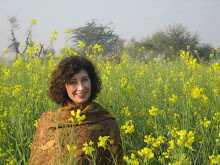
I was sad to read in the newspaper that the legendary Maharani of Jaipur, Gayatri Devi, passed away on July 29 at the age of 90. She was an icon of India's former princely states, renowned for her beauty, charm, and eventually her devotion to education for women and a successful political career. With her death came the end of a reign rich in history, romance, and the allure of an early life of royal privilege.
The Maharani's former residence in Jaipur was Rambagh Palace, where she lived with Maharaja Sawai Man Singh II. In 1957 it was converted to a hotel. It remains a stunningly gorgeous heritage hotel to this day.
During my first trip to India I visited the palace, sat on the veranda sipping a kir royale and watched green parakeets fly overhead above the vast manicured lawns. It was magical. And very palatial. With a grand entrance, polished marble floors and corridors, fountains filled with rose petals, and portraits of royalty, it conjured up bygone days of royal activities and immense wealth.
At Rambagh Palace the service is stellar, and the amenities ample including spa, swimming pools, jewelry boutiques, and astrologer. If you truly want the royal treatment, opt to stay in the Maharani's suite. The Maharaja had it redecorated especially for her (she was, in fact, his third wife).
For more on the Maharani's fascinating life including her days at Rambagh Palace, read her autobiography, "A Princess Remembers." It will make your stay or visit to the Palace all the more memorable.





















